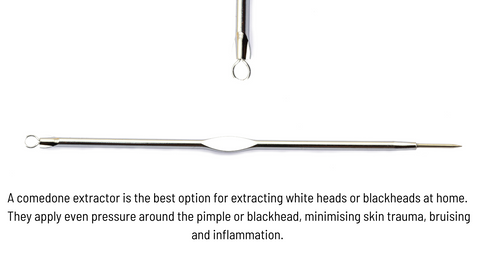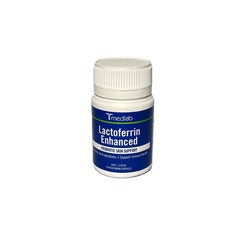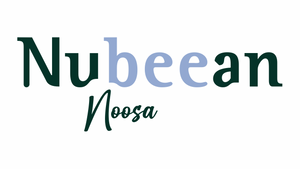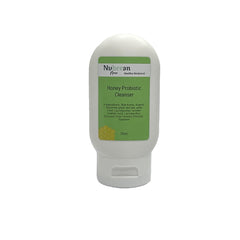🌋 How to Pop a Pimple Properly
Stop messing with your skin & learn how to pop a pimple properly!
Squeezing a pimple with your fingers is a guaranteed way to create a mess that takes ages to heal and leaves behind both a scar and pigmentation to remind you of its presence.
If you’re prone to regular pimples, the best thing that you can do is to train yourself out of touching your face, squeezing or picking.
Most of us know that picking, squeezing or popping pimples at home is a big no no. However, the urge to squeeze a pimple is a powerful one and most people will confess to squeezing or trying to extract whiteheads at home.
Popping and extracting a pimple the correct way can remove the urge to pick and squeeze, helping the offending pimple to heal faster and with a significantly reduced risk of scarring or pigmentation.
DO NOT use this technique on inflammatory or cystic acne no matter how tempted you are to try it. It will not speed anything up, it will have the exact opposite effect. This technique is suitable only for whiteheads or blackheads. You risk creating significant scarring and even infection AND you’ll still be left with a painful cyst under your skin.
While it might seem a lot of preparation and work and require a lot of gear vs a quick squeeze with your fingers, once you've experienced how quickly a properly and safely popped pimple heals without scarring or pigmentation, you'll be converted and never want to squeeze again.
Keep all your pimple popping gear in a small container so that it's all clean and ready to use with everything in the one place whenever you need it.
Here’s what you’ll need
- Disposable single use lancets (the same type diabetics use for pricking their finger tips to test their blood sugar levels. You can buy these either online or from any pharmacy)
- A pimple/comedone/blackhead extractor (from any pharmacy or online – you can buy sets of varying shapes and sizes for under $10)
- Isopropyl alcohol to sterilise the pimple extractor before use (supermarket or pharmacy).
- Hydrocolloid pimple patches (you don’t need the medicated ones, just the regular hydrocolloid patches which draw the fluid out of the extracted pimple.)
- Vaseline, PawPaw ointment or a balm that contains at least 60% beeswax

The reason that disposable lancets are recommended over the old-fashioned approach of sterilising a needle with alcohol (or a lighter):
- If you don’t sterilise a needle or pin properly, you risk introducing bacteria into your pimple and the result will not be pretty or fun. It's just no worth the risk.
- As you can see from the pics below, the tip of the disposable lancet is far sharper than the sewing pin next to it. Pins and needles are created to push through fabric, lancets are designed to puncture human skin with the tiniest hole possible.

When is the best time to pop a pimple?
Popping a pimple is best done in the evening before bed so that your skin has sufficient time to recover. It also means that you can leave the popped and extracted pimple to finish draining properly while you sleep without the need to try and cover it with makeup or concealer.
Wash your face to remove any makeup, perspiration etc... before starting. If you're also going to be extracting blackheads, exfoliate your skin first too.
It's a good idea to apply some warm compresses over the pimple before popping and extracting. The steam and warmth helps to soften the pimple and increases circulation to the area.
How to apply a warm compress
Use a clean face washer and warm water. Wet the face washer/cloth in the warm water and squeeze the excess water out before holding the warm, damp cloth over your pimple and surrounding skin. Hold for 10-20 seconds and then repeat several times.
Please only use a clean face cloth, not a damp and stinky one that's been hanging up in your shower for several days (or weeks 😱)
Now you're ready to Pop that pimple safely and properly!
Ensure that you also wash your hands well before starting and when finished.
Step 1:
Sterilise the extractor
Use the isopropyl alcohol to sterilise the extractor. Spray thoroughly and then allow to air dry on a clean paper towel.
Step 2:
Pierce your pimple with disposable lancet
If you are dealing with several pimples at once use a clean disposable lancet on each one.
Hold the lancet parallel to your skin and then gently prick that zit in a smooth horizontal motion. Try to use as little pressure as possible. All you're trying to do at this point is create a clean and tiny opening for the dead skin cells, pus and fluid to drain.
The lancet should just break the surface, don't push it into the pimple.
Step 3:
Extracting the pimple
Use the sterilised extractor on the pimple to remove the 'head' (a combo of dead skin cells, pus and other fluids).
Apply even pressure to prevent any tissue damage. Do not drag the extractor across your skin. Don’t press the extractor too firmly either. Keep applying gentle and even pressure until the contents of your pimple (or blackhead) have been pushed out. Wipe clean and resist any urge to touch, pick or squeeze.
Wash your extractor with hot, soapy water and allow to dry before putting it away.
Step 4:
Apply the hydrocolloid pimple patch
Wipe the area clean and apply a pimple patch – this allows the pimple to finish draining. It also keeps what is essentially now a small wound in your skin moist which allows for healthier healing and reduces inflammation, scarring and pigmentation.
Don't apply any lotions or potions under the patch. Your body knows what to do and how to heal without any extra support from skincare products. Make sure your skin is clean and dry before applying so the patch sticks properly to your skin and won't come off in the middle of the night.
You can buy pimple patches that are precut into a nice round shape to fit over a pimple. You can also buy the larger hydrocolloid dressings and cut them yourself at home. Hydrocolloid dressings are meant to be self adhesive (stick to the skin) but you can also hold them in place with a small piece of Hytape so that they stay on overnight. Hytape is latex free and uses zinc oxide to help it stick to the skin. You can also use regular micropore tape to hold the hydrocolloid dressing/pimple patch in place if your skin isn't sensitive.
You don’t need the more expensive medicated patches – these are more likely to cause a reaction especially if you have sensitive skin.
What is a hydrocolloid pimple patch? Hydrocolloid dressings are designed to provide a moist and insulated wound healing environment (for non infected skin wounds). They help to protect a wound and allow your body's own enzymes to get work and heal up the injury to your skin. Keeping a wound moist is the most effective way to allow injuries to skin to heal with minimal scarring and pigmentation.
Hydrocolloid pimple patches contain moisture absorbing ingredients that help to draw out fluid, pus & oil from your neatly popped pimple. Most importantly they also act as a barrier against sneaky grubby fingers picking, squeezing or touching your [ex] pimple and creating skin damage that produces the inflammation and pigmentation.
Step 5:
Healthy healing
Next morning remove the pimple patch and gently clean your skin.
You now need to create a barrier over the ex-pimple to stop it drying out and turning into a scab. Keeping it moist will allow it to heal faster and with less risk of scarring and pigmentation. Vaseline works well, as does pawpaw ointment. You can also use a balm with a high percentage of beeswax. This will not block your pores and form another pimple.
Re-apply as needed during the day and before bed – ensure your hands are freshly washed before applying anything.
If you are a picker and find yourself picking your skin without even realising that your doing it, skip the vaseline/pawpaw/balm and slap on another pimple patch during the day to act as a barrier against fidgety fingers. Yes you can see the patch on your skin but it's a small price to pay to allow that pimple to heal up cleanly and quickly. A day or two wearing a small bandaid looking patch on your face really is worth it in order to avoid weeks and months of pigmentation and skin trauma.
What can you do for a pimple that isn't ready to pop?
You should only ever pop a pimple that has a white head on it. If your pimple isn't ready to be popped, you can help it along by applying warm compresses as detailed above. Apply them 2-3 x daily. You can also use a lactic, glycolic or salicylic acid product just over the spot to help bring it to the surface faster.
________________________________________________________
This method of popping a pimple is safer than trying to squeeze with your fingers. The pimple will heal faster and cleaner. It reduces the risk of infection and inflammation which cause scarring and pigmentation. Please note that this is only to be used for non inflammatory acne - whiteheads and blackheads. Do NOT use for inflammatory or cystic acne.
Subscribe and stay up to date📜. Healthy Skin and Gut news delivered to your inbox 📬

About Sarah Luck
Sarah is a naturopath and nutritionist with over 20 years of working with clients around Australia, UK and USA.
Her approach to skincare is unique as she views your skin as your body's largest organ. She has a special interest in creating skincare for sensitive skin as well as a wholistic approach to working with sun damage in the over 35's.
Sarah believes healthy skincare should be beautiful, simple and safe.
Honey Probiotic Cleanser
A 100% natural cleansing experience based on raw honey from mostly Paperbark tree blossoms in the Noosa Hinterland region. Honey Probiotic Cleanser gently exfoliates and balances skin. The unique application method also helps to stimulate your skin's lymphatic system to cleanse from the inside out.
BlackSeed & Kunzea Oil Cleanser
A powerful and multitasking medicine oil based on Black Seed oil (Nigella/Black Cumin Seed), Kunzea from Tasmania and Squalane from olives & sugarcane.
Use as an oil cleanser to remove makeup and zinc based sunscreens. Can also be used as a leave on treatment oil for inflamed, dry or scaly skin. Makes a great oil treatment for itchy, flaky and scaly scalps.
Probiotic for Acne Prone Skin

 Skip to content
Skip to content


